
NPS Photo The cacti in the monument may tower over the trees, but small trees and shrubs are the most widespread species here. They flourish along the seasonally soaked washes and springs, and spread out over the arid valley bottoms. Sonoran Desert trees have an intriguing toolbox of adaptations for surviving and thriving in extreme elements. Traditional and contemporary uses of desert plants range from foods and medicines to cosmetic products. Here in Organ Pipe Cactus National Monument, all trees and shrubs are protected so they will be preserved for future generations. Below is a list of some of the trees and shrubs that you may encounter during your visit. 
SEINet photo/Zachery Berry Creosote bush (Larrea tridentata)Creosote is one of the most common shrubs in the monument and is a member of the "creosote bush scrub" community of plants in the Sonoran and Mojave deserts. This aromatic shrub is evenly spaced along with burrobush and triangle-leaf bursage in the flat valleys between mountain ranges. A chemical on the leaves produce a tar-like scent when humidity is high, causing human inhabitants of the Sonoran and Mojave Deserts to associate the distinct smell with rain. On a dry day, you may breathe on leaves to mimic humidity and experience the smell of desert rain. Identify this PlantLook for small thick leaves shaped like pointed ovals, with two sprouting from a bud. Creosote flowers are bright yellow with five rounded petals. The fruit appears as small fuzzy white balls. Creosote grows 3-10 feet tall (1-3 m). 
SEINet photo/Max Licher Triangle-leaf bursage (Ambrosia deltoidei)Triangle-leaf bursage is one of the most common shrubs in the Sonoran Desert, alongside creosote and burrobush. It commonly provides protection and shade to vulnerable seedlings of slower growing plants such as saguaro and prickly pear cacti, as well as ocotillo and paloverde, lending it a title of a “nurse plant”. This small shrub looks similar to brittlebush, but can be distinguished by its smaller, triangular leaves and if in bloom, its singular spike of flowers. Identify this PlantTriangle-leaf bursage is a short, stocky plant, usually growing 2 feet tall (0.5 m). Young, triangle shaped leaves are covered in wooly hairs that disappear with age. Flowers grow on a stalk, in clumps, leaving behind a spiky seed pod. The leaves look similar to brittlebush leaves at a glance, but can be distinguished by their more uniform, smaller size, and their triangle shape. Brittlebush has diamond shaped leaves and many flower stems. 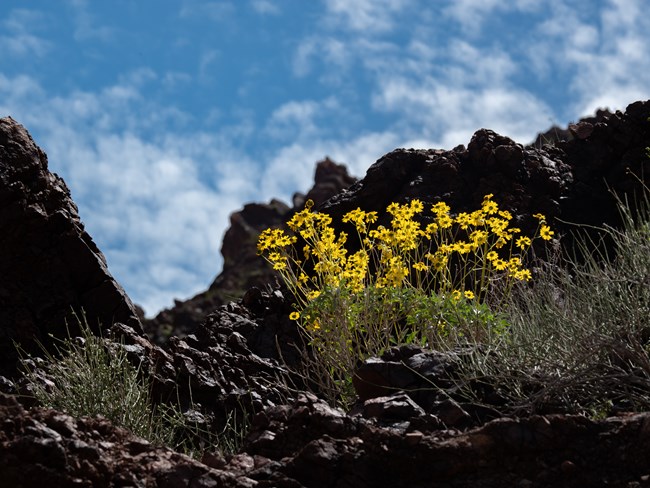
NPS photo/Andrew Cattoir Brittlebush (Encelia farinosa)Brittlebush is especially common along roadsides, where a little extra run-off may cause some plants to produce occasional out-of-season blossoms. Brittlebush contains an aromatic resin that was burned by Spanish missionaries as incense; because of this, it is also known as “incienso”. Identify this PlantBrittle bush grows up to 3 feet tall (1 m), and is usually a dense mound. Leaves are a distinct round diamond shape and wooly. Flowers are yellow with many petals, appearing "daisy-like". Brittlebush can be recognized when not in bloom by the halo of dried flower stems that extend above the leaf-bearing branches. 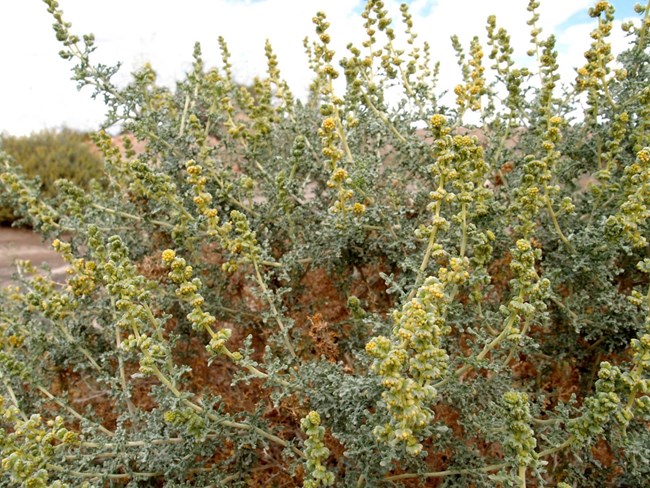
SEINet photo/Sue Carnahan Burrobush (Ambrosia dumosa)Burrobush is one of the most common shrubs in the monument, along with triangle-leaf bursage and creosote. It is a ragweed that grows up to three feet (a little less than one meter) tall in a mounded clump. The branches are fine and tangled, holding onto dry branches from previous seasons, giving the plant a messy look. Identify this PlantBurrobush sports many errect branches growing up to 1-2 feet tall (0.3-0.7 m). Small, tear drop shaped leaved grow in many clusters of two or three along the branches. Flowers are small, yellow to white, and grow in clumps, leaving behind bur-like seed pods. 
NPS photo Jojoba (Simmondsia chinensis)The Native peoples of the region used the unique wax of the jojoba nut in soothing salves and balms. The plant has been commercially cultivated since the 1980's for use in shampoos and cosmetics. Jojoba is native to the Sonoran Desert and can be found in higher elevations along the Ajo Mountain Drive. Male and female flowers are found on separate plants and only the female plants produce the acorn shaped nuts. Identify this PlantJojoba is typically 3-6 feet tall (1-2 m), and densely covered in leaves. Leaves are slender ovals with a rough texture and dusty blue-green color. Flowers grow in small clusters and a greenish yellow. Seeds are a rich brown, acorn shaped and wrinkled. 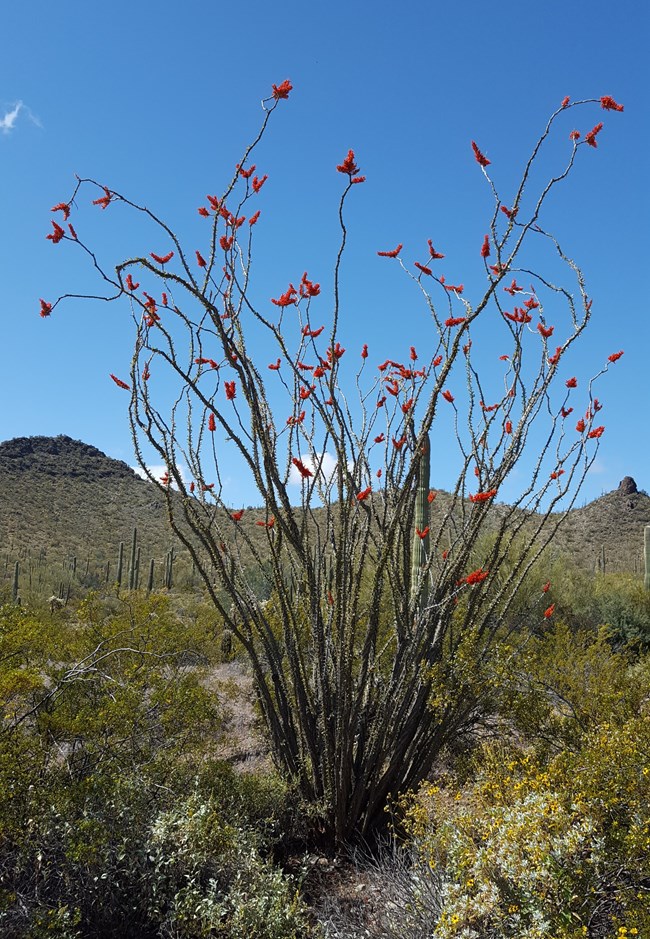
NPS photo Ocotillo (Fouquieria splendens)Ocotillo are often mistaken for cacti because they are spiny and leafless during dry periods, but these plants are more closely related to blueberries! Their long branches have chlorophyll to enable the plants to photosynthesize without leaves, but leaves will appear shortly after a good soaking rain. These dense, thorny plants are sometimes planted close together to create a "living fence". Identify this PlantThe ocotillo is a distinctive plant with many long, winding branches reaching up from the base. The branches are rigid with large thorns. After a ground-soaking rain, small rounded leaves sprout from all around the branches, and clusters of fiery red tubular flowers at the tips give the plant its nickname "candlewood". Ocotillo are commonly 10-15 feet tall (3-4.5 m). 
NPS photo Palo verde (Parkinsonia sp.)Two species of palo verde are found in the monument. Foothill palo verde (P. microphyllum), is a slightly brighter green than the blue palo verde (P. florida), which is more dusty blue. Palo verde is Spanish for “green stick”, which describes the green branches and trunk. The green color of the plant allows it to turn sunlight into fuel, or "photosynthesize" even when leaves fall in time of drought. Identify this PlantThe easiest way to find these 16 foot (5 m) tall trees is to look for entirely green trunks and spiny branches. Both trees' leaves are made up of smaller, paired leaflets from a central stem. The leaflets of foothill palo verde are smaller and number 4-8 pairs; blue palo verde leaflets are larger and number 3-4 pairs. Both trees' seed pods look similar to green beans. 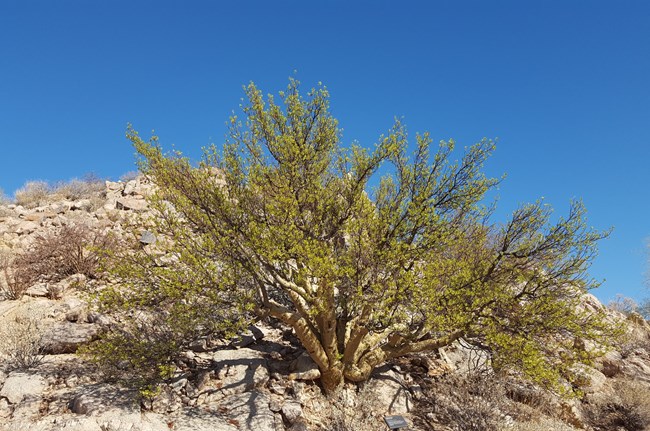
NPS photo Elephant tree (Bursera microphylla)Elephant trees get their name from their flaky, succulent trunk and lower branches which resemble the limbs of an elephant. These trees secrete an aromatic resin that can be used in incense. While individual trees are scattered throughout the monument, the area around Lost Cabin mine is the best place to see many elephant trees in the same area. These trees are a rarity in the United States, and this area holds some of the northernmost specimens. Identify this PlantElephant tree is generally short and stocky, but can grow up to 33 feet tall (10 m). The trunk is short and wide, with branches sprouting low from the tree. Leaflets are arranged in several pairs along a central stem, with one leaflet at the tip. Flowers grow one or two at the end of a long shoot are cream to pale yellow in color, leaving dull brown fruits that split when ripe.
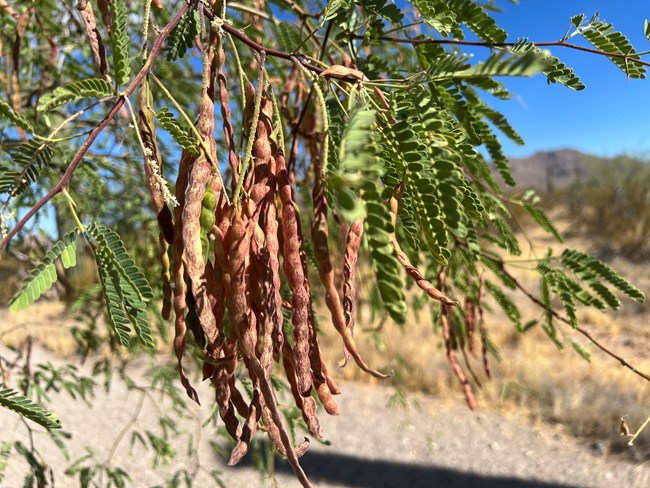
NPS photo Mesquite (Prosopis velutina)Mesquite has been one of the most useful plants in the Sonoran Desert to native people and early settlers. The calorie rich pods and seeds can be ground into flour or roasted like coffee. The wood is useful for tools, building materials or burning for an aromatic flavoring smoke. The fibrous bark can be made into baskets, and the flowers are a popular source of honey. At night, leaves will fold closed along the central stem.Identify this PlantMesquite trees typically grow 26 feet (8 m) tall and are armed with long spines along young branches. leaves grow in 14-24 pairs of leaflets along a central stem. Flowers are white to yellow, fuzzy and petal-less, and densely packed onto a central spike. Seed pods are long and slightly curved, turning a deep red-brown when dried.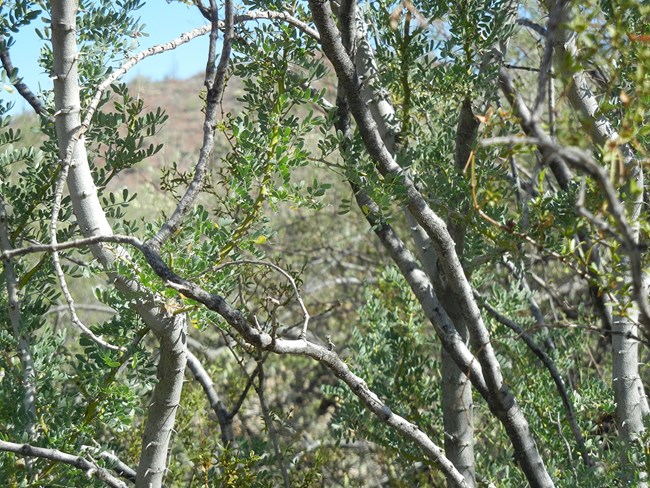
NPS photo/Alice Wondrak Biel Ironwood (Olneya tesota)Ironwoods are long lived, slow growing, and one of the largest trees of the Sonoran desert. Their size provides plenty of shade, and this may attract animals during the heat of the day. The wood of this aptly named tree is extremely dense and resistant to decay but is also difficult to process commercially. Traditionally, the strong wood was used in the crafting of tools and as a hot-burning firewood. Most of its modern uses are artisanal, famously used by the Seri indigenous people of Sonora, Mexico, to carve animal figurines.Identify this PlantIronwood can be recognized by its gray bark and dusty-green leaves. Small spines line branches and twigs. Wide, oval shaped leaflets grow in 3-7 unorganized pairs along a central stem, with one leaflet at the tip. The showy flowers are purple to pink and give way to red-brown seed pods. Older specimens can grow up to 33 feet (10 m), but most trees in the park will be 15-20 feet (4.5-6 m).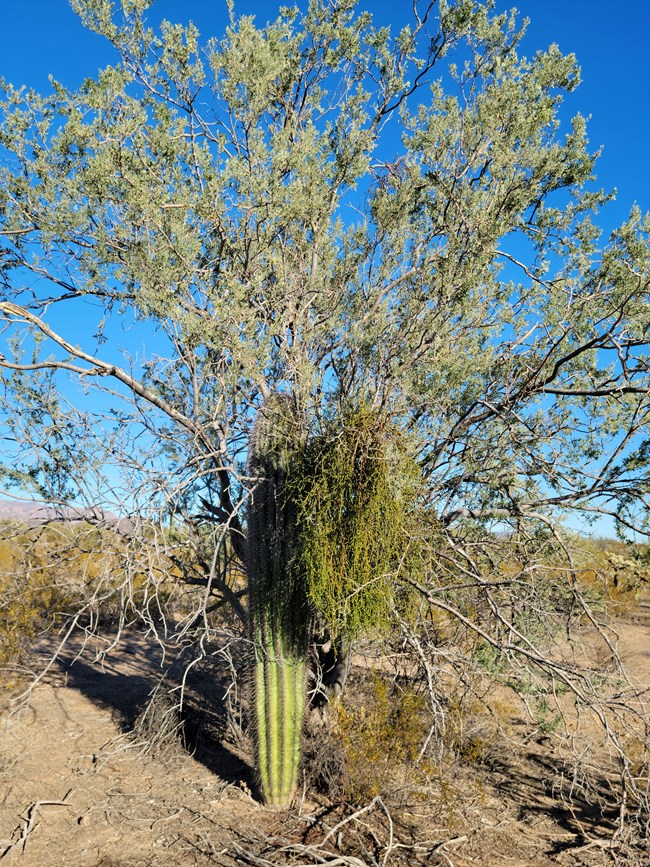
NPS photo Desert mistletoe (Phoradendron californicum)Desert mistletoe is leafless but is still able to harness energy from sunlight, or “photosynthesize”; however, this plant cannot obtain its own water or minerals through a root system, and instead must sap the nutrients from a host plant to survive, making it a “parasite”. Because this species does half of its own work and meets the rest of its needs through parasitism, it is considered a “hemiparasite”. Even though other parts of the plant are highly toxic, some Indigenous Peoples traditionally harvested and ate the berries in the winter and early spring. These berries are also a dependable source of food for the phainopepla bird, which will consume berries and deposit the undigested seeds onto other host plants. Identify this PlantDesert mistletoe is found in large, “nest-like” clumps of bright green to brown stems, mainly on ironwood, mesquite, and palo verde trees. Flowers are small and yellow, turning into salmon pink berries that fade to a translucent white. A small clump of mistletoe may be found in a tree, or several large clumps may appear to take over the host plant. 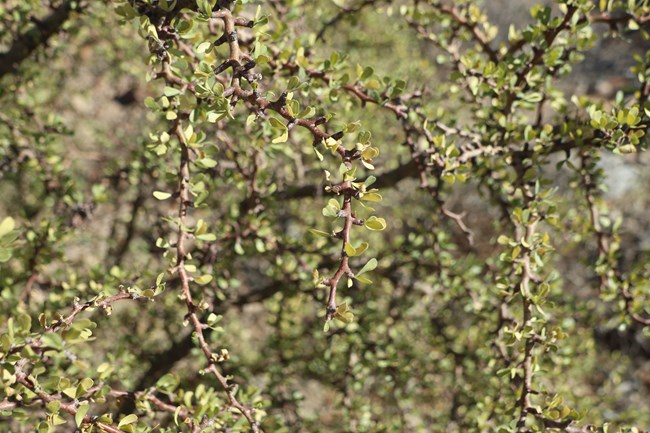
NPS photo Desert limberbush (Jatropha cuneata)This plant stores some water in its flexible, reddish-brown stems and branches, making it semisucculent. Limberbush was traditionally used in basket making, the O’odham and Seri Peoples harvesting and splitting the durable stem to be woven into utilitarian baskets. The richly colored sap and tuber were also used in leather tanning and dyeing processes, as well as a medicine for toothaches. Identify this PlantDesert limberbush is a small shrub, typically growing 3-5 feet tall (1-1.5 m). The stems are smooth, with many joints where leaves stem from. Increasing humidity in mid-summer brings on elongated, heart shaped leaves that grow in size when the seasonal monsoon rains begin. Small, white, bell-shaped flowers are also prompted by the monsoons of late summer. 
NPS photo Bitter Condalia (Condalia globosa)Bitter condalia is a slow growing shrub that has hard wood, making it highly desirable as firewood. Bitter condalia is sometimes called bitter snakewood. Identify this PlantBitter condalia is not an abundant shrub in the park, but look for a tangled looking pant, growing 8-15 feet tall (2.5-4.5 m), in or near arroyos. Leaves are small and oval shaped, cupped inward from the top side, and grow in small bunches. During the late summer monsoons, the bitter condalia’s greenish-yellow petal-less flowers are fragrant and attract insects. Fruits are brown to black. 
SEINet photo/Liz Makings White-thorn acacia (Vachellia constricta)White-thorn acacia is typically used as an ornamental plant, as a small tree fixture in native gardens, or trained into hedges. This long lived plant’s seeds are typically eaten and spread by quail and kangaroo rats. Identify this PlantWhite-thorn acacia are medium shrubs, growing 3-7 feet tall (1-2 m). Leaves consist of smaller oval shaped leaflets, arranged in 4-16 pairs down a central stem, and those groups of leaflets arranged in 3-9 pairs down a larger stem. White-thorn blooms in late spring, then again in early fall, with distinct yellow, spherical, petal-less flower bunches. Seed pods are long, thin, and hanging. 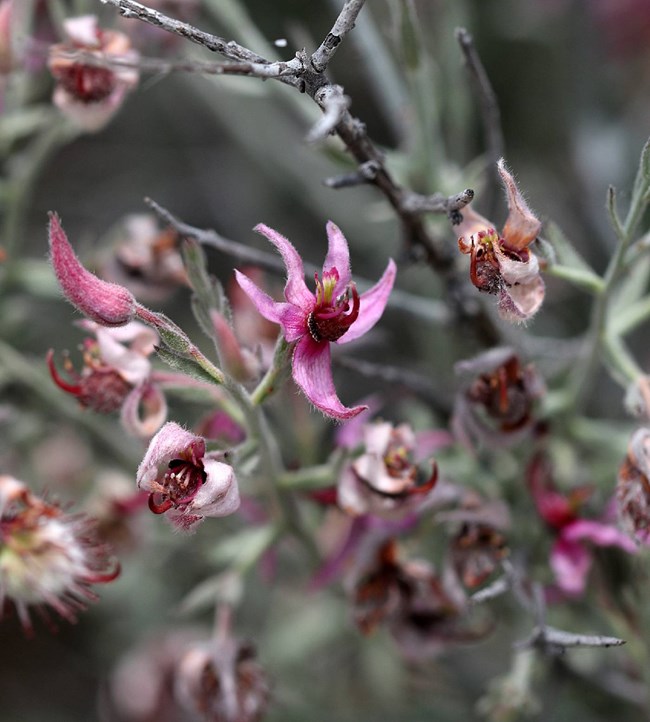
SEINet photo/Liz Makings White ratany (Krameria grayi)White ratany is well adapted to the hot Sonoran Desert, growing in most habitats except dunes. It is an important source of food for deer, sheep, and even the cattle that historically grazed the area. The roots can be processed into a reddish-brown dye for use in basketry. White ratany is a root parasite, tapping into roots of nearby shrubs, such as creosote, to gain water and nutrients. Identify this PlantWhite ratany grows 1-3 feet tall (0.4-1 m), and is densely branched, often at right angles. Branches are slender and often leafless, with spines, and covered in fuzz. The occasional leaves are small, but relatively long, lance-like, and grayish with a fuzzy layer. Flowers are magenta to purple inside, and white and slightly hairy on the outside. Fruits are dry and bur-like with thin spines. More About Sonoran Desert Plants |
Last updated: August 19, 2023
